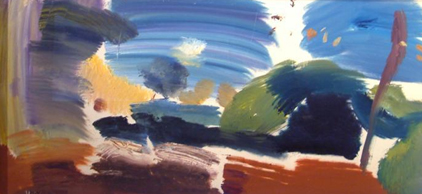Andrew Graham-Dixon on an exhibi-tion of landscape paintings by Ivon Hitchens at the Serpentine Gal-lery
IN AUGUST 1940, a German bomb landed on 169 Adelaide Road, London NW3. The painter Ivon Hitchens was living there at the time, and the blast turned out to be the most significant event in his career - though not as terminally significant as it might have been. Surviving the explosion, Hitchens left the wreck of his house and studio, moved to Pulborough in West Sussex and shortly afterwards acquired a patch of scrubby woodland near Petworth. The locale must have appealed: Hitchens lived and worked there for al-most four decades until his death in 1979, a permanent refugee to nature.
Hitchens's demenagement was hardly the most conspicuous of artistic migrations: West Sussex has somehow never had quite the glamour or mystery of, say, Gauguin's Tahiti. Writing in the mid-1950s, Patrick Heron memorably described Hitchens's retreat, a downbeat affair: 'He retired to a caravan he had lately pur-chased for pounds 20 and driven to a thicket on Lavington Common composed of rhododendron and silver birch, with oaks above and bracken below. Here, with more turpentine than water, he remained, with his wife and infant son for company, to paint the war out. And there today, in this setting of dense undergrowth, the air a misty green with the confetti of birch leaves, his one-storey house spreads itself, and is all but invisible from a distance of 10 yards.' Hitchens christened the house 'Greenleaves'; even he, it seems, baulked at 'Mon Repos' although that, clearly, is what it had become.
'Ivon Hitchens: Forty-Five Paintings' offers Hitchens reduced, Hitchens made manageable, his prolific output of around 2,000 paintings boiled down to what the organisers must feel are the sure-fire hits. Entering Hitchens country you go to ground,...


